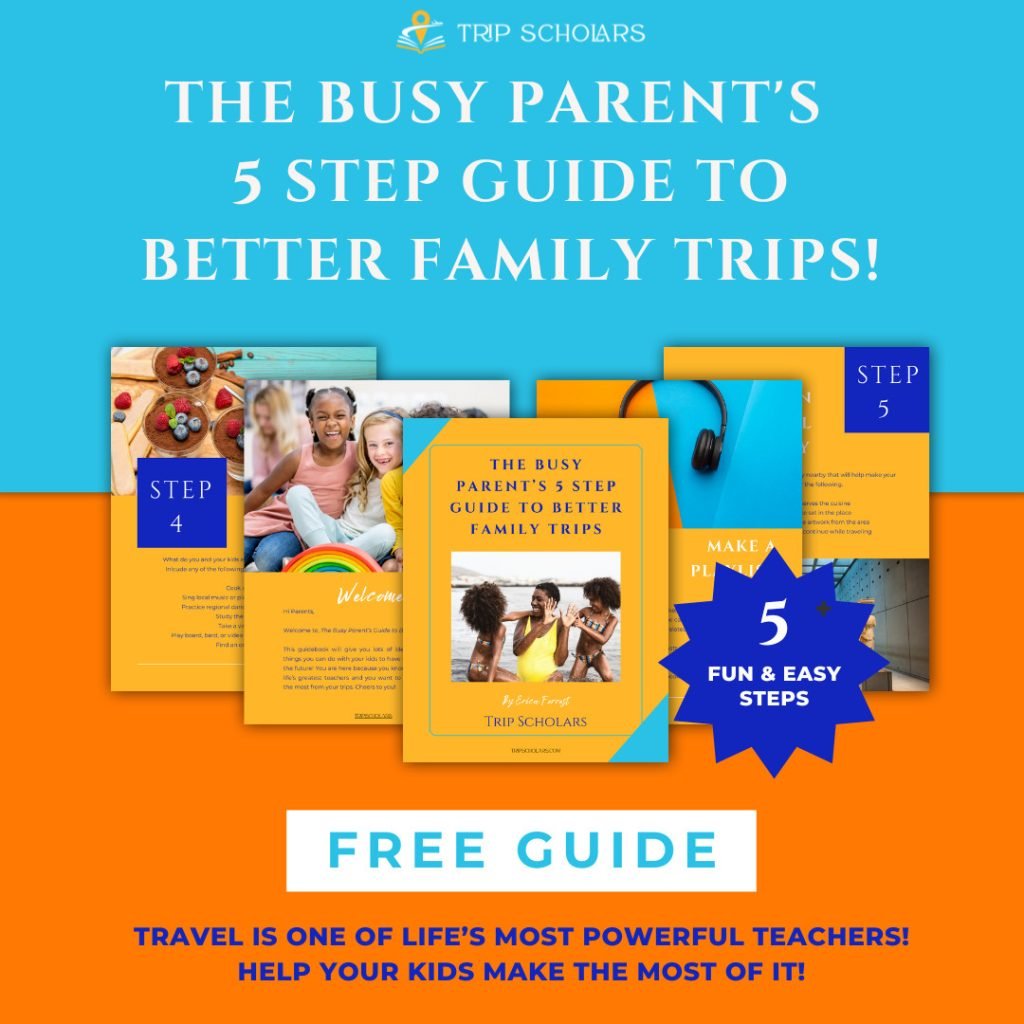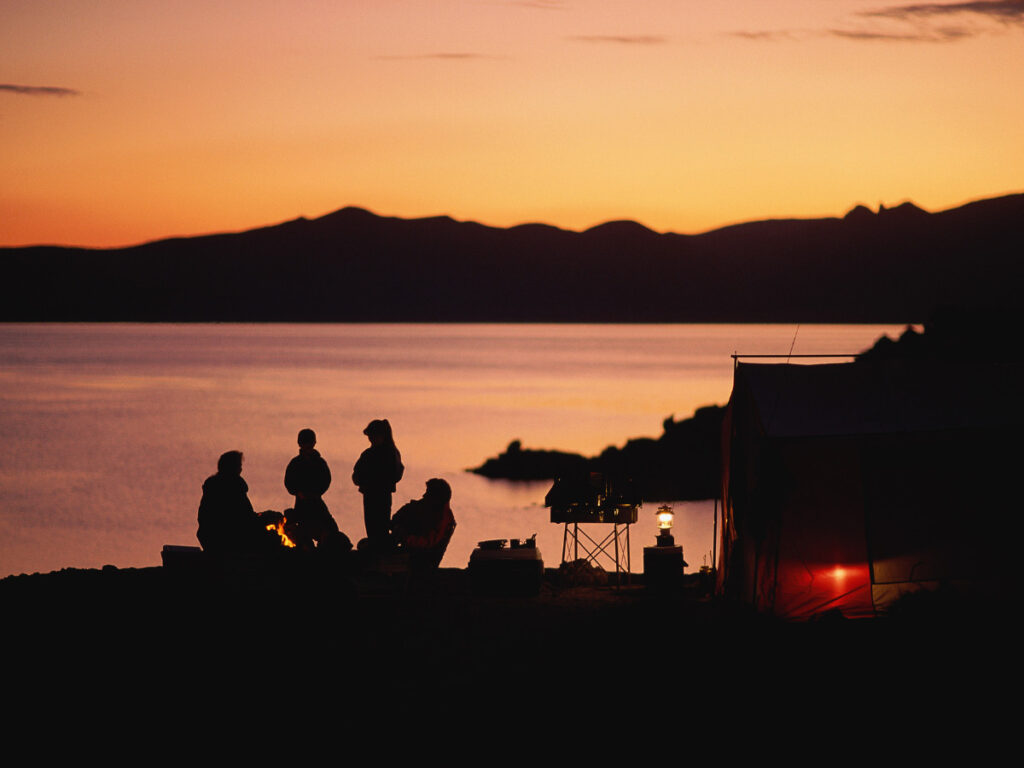Multigenerational family vacations provide opportunities for family members of all ages to explore, to learn, and, most importantly, to connect with each other. The best intergenerational trips are those that resonate with all family members, from the thrill-seekers to the history buffs, from toddlers to teens to grandparents.
Although intergenerational vacations can create incredible memories and connections that will last a lifetime, by their very nature, they are also filled with challenges. How do you meet the needs of so many people and get everyone invested in the trip? Is there a way to build in opportunities for privacy, down time, and connection? How can you navigate costs and logistics?
I am a travel education coach and advisor and have worked with families navigating these common challenges. You aren’t alone! No matter how much we love our extended family and cherish the opportunity to vacation together, traveling in any larger group is inherently more challenging. In this article, we will explore the joys, challenges, and transformative power of traveling with family across generations. We will also highlight the top tips so that you and your loved ones can enjoy enriching multigenerational family vacations that create memories to last a lifetime. Let’s get started!
This post may contain affiliate links which means Trip Scholars may make a small commission (at no extra cost to you) if you make a purchase. As an Amazon Associate I earn from qualifying purchases. Read more here. Thanks for your support!
1. Communication is Key for the Best Multigenerational Family Vacations
When planning the trip, involve everyone in the decision-making process. This isn’t just about picking destinations but also about aligning on the types of activities that will keep everyone engaged and happy. For instance, when there are differences in interests—like a love for museums vs. a preference for beaches—find a middle ground that incorporates both. By addressing everyone’s concerns and suggestions upfront, you can plan a trip that balances relaxation with adventure, ensuring a memorable experience for all family members.
Effective communication lays the foundation for a successful multigenerational vacation. It is crucial to establish open lines of dialogue about expectations and preferences long before you pack your suitcases. This means adults having honest conversations about safety, finances, routines, and parenting styles. Are there specific dietary, health, or mobility issues that can be talked about early on?

2. How to Choose the Best Multigenerational Travel Destinations
Selecting the right destination is important for a memorable multigenerational trip. Look for places that offer a variety of activities and that cater to different ages and interests. It’s important to pick locations where both kids and adults can find something enjoyable to do, and where different family members can comfortably join in or have their own adventures. Here’s a streamlined approach to ensure your destination hits the mark:
- Consult with Everyone: Have family conversations to discuss everyone’s interests and things they are most interested in seeing. This ensures the destination has something for everyone.
- Plan Together: Involve the family in the research and planning process. This is a major focus of Trip Scholars and you’ll find lots of ideas throughout this website. Grab a free copy of The Busy Parent’s 5 Step Guide to Better Family Trips!
- Consider Accessibility: Choose places that are easy for everyone to navigate, especially if you have family members with mobility and health issues.
- Look for Variety: Destinations with a mix of cultural, recreational, and relaxing activities are ideal. This way, you can alternate between action-packed days and downtime.

Great Multigenerational Vacation Destinations
- National Parks: these gems offer nature, wildlife, and outdoor activities suitable for all energy levels.To get started check out this post on visiting Yellowstone National Park, and this one about visiting Yellowstone with children.
- Cultural Cities: Cities rich in history and culture provide educational tours, museums, and landmarks. Enjoy this post on visiting museums and this one on visiting museums with kids for some ideas to get started.
- Beach Vacations: Ideal for relaxation and water activities, ensuring both kids and adults have fun. Here are articles on Hawaii and Greece to get you started.
- Cruise Vacations: With stops at various ports, there’s something for everyone, from onboard entertainment to excursions. Although some cruises are hard on local communities and the environment, there are also fantastic smaller ship cruises and river cruises that overcome these challenges.
- Heritage Tours: Destinations that connect with your family’s ancestry can add a personal touch to your travels. Ready for more? This post has lots of ideas for diving into creating your own heritage tour.
By focusing on these elements, you can choose a destination that ensures everyone from the youngest to the oldest family members will have a memorable experience.

3. Get Everyone Invested in the Intergenerational Trip
If you have ever been frustrated with kids playing games on their phones while driving through a national park or teens wanting to stay in the hotel room when you have planned an excursion to a world class museum, you are not alone! These experiences are very common. They are frustrating not only to the adults who have invested so much time and money into the trip, but also to young people who may not be interested in what has been planned for them or those who feel like they don’t have much autonomy and control of their time in the midst of the trip.
To ensure a vacation resonates with each family member, it’s very helpful to mesh individual interests with the chosen destination, transforming the vacation into an enriching journey for all. Before planning the itinerary, begin by reflecting on each person’s hobbies and passions, from cooking and sports to reading and history.
The Trip Scholars website is filled with articles that help bridge interests with travel destinations, offering creative ways to plan engaging activities everyone will enjoy. This post is filled with lots of ideas for planning trips with kids. Grab our free “Busy Parent’s 5 Step Guide to Better Family Trips,” for your personalized guide to finding the best options for your family.

Find the Best Options for Your Family
For the budding chefs in the family, kick off the excitement by experimenting with recipes from your destination country before departure. This not only introduces them to new cultures through cuisine but also invites them to participate in choosing restaurants, cooking classes, and food tours during the trip. Engage the family in pre-trip activities that connect with your travel plans, such as building a LEGO set of a notable landmark you’ll visit or watching movies set in your destination, to kindle the flames of anticipation and curiosity.
Encourage children to dive into planning by researching attractions that spark their interest, like snorkeling spots for marine enthusiasts. Opt for interactive educational experiences, such as museums with hands-on exhibits or nature hikes guided by experts, to make learning a joyful part of your adventure. Reflecting on what each person discovered or enjoyed most about the day’s activities can deepen family connections, making every moment of your trip a shared treasure and a stepping stone to lifelong learning and curiosity.

4. Budgeting for Everyone on Your Multigenerational Vacation
Effective budgeting is vital for ensuring that a multigenerational trip remains enjoyable and as stress-free as possible for everyone involved. It’s essential to recognize that family members likely have differing financial situations, and planning should accommodate these differences to keep the trip inclusive and comfortable.
A practical approach is to discuss the budget openly at the planning stage, setting clear expectations about what expenses will be shared and which will be individual. You’ll find tips on creating your budget and planning your itinerary in this step-by-step guide.
Consider accommodations that offer flexibility and privacy, such as vacation rentals with multiple bedrooms or adjoining hotel rooms. This setup allows families the option to split costs in a way that suits their budgets, providing both communal spaces for gathering and private areas for downtime.
Additionally, exploring separate lodgings in close proximity can offer a balance between togetherness and independence, catering to varying budget constraints and personal preferences. If you are visiting a national park, some people might choose affordable tent camping under the stars, while others stay in more comfortable and accessible rooms in a nearby lodge.
Inclusive Options
Also consider creative ways family members can contribute with time instead of money. For example, some adults might cover the costs of shared lodging for everyone while those with tighter budgets can offer to make more of the meals or do more of the planning before departure. I’m also a travel advisor and can assure you that planning the logistics of a trip can be very time consuming! This can be a great way to balance the load so everyone feels like they are contributing fairly.
When planning activities, include a mix of free and paid experiences. Museums, parks, and historical sites often offer enriching opportunities at little to no cost. In fact, I include a whole section in this article on visiting museums for free or at reduced costs.
For dining, mixing meals prepared at your lodging with dining out can help manage food expenses while still allowing for culinary exploration. By prioritizing flexibility and open communication around finances, families can ensure that their multigenerational vacation is enjoyable and accessible for all members, regardless of their budget.

5. Accommodations and Logistics on Multigenerational Holidays
Choosing the right accommodations is another important component of successful multigenerational travel. It’s not just about a place to sleep; it’s about creating a home base that enhances the vacation experience for everyone.
Accommodations
When booking accommodations, consider options with spacious common areas where the family can gather, such as living rooms or outdoor patios. It’s equally important to ensure there are enough bedrooms or separate spaces so everyone can have their privacy when needed. Vacation rentals, for instance, can offer the perfect blend of shared and private spaces, often coming equipped with kitchens that allow for easy meal preparation and can help save on dining costs.
Logistics
Logistics also play a critical role in the enjoyment of your trip. This includes considering the location of your accommodations in relation to the activities and attractions you plan to visit. Being centrally located can reduce travel time and make it easier for family members to take breaks or return early if needed. Older kids and teens may appreciate having more autonomy that is provided when they can get back to the shared lodging on their own.
Additionally, consider transportation options. Sometimes it is less expensive to rent a vehicle for the whole family than it is to utilize public transportation, so give thought to the best way to get around.
In planning the logistics of your trip, remember to account for the pacing of activities to accommodate the energy levels and interests of all generations. This might mean scheduling more demanding adventures earlier in the day and allowing for rest or leisure time in the afternoon. One of my top tips for group travel is going in with the expectation that everyone will not participate in every activity.
It can also be a very thoughtful gesture to encourage small group activities. For example, an offer of childcare so that parents of younger children can have a date night in the middle of the trip is generous and almost always greatly appreciated. Similarly, encouraging a spouse to have some alone time with one of their parents or with their siblings can be a great idea.
By thoughtfully addressing accommodations and logistics, you can create a comfortable and enjoyable travel experience that meets the needs of every family member, making your multigenerational trip a truly memorable adventure.

6. Multigenerational Travel Health and Safety Considerations
When planning a multigenerational trip, prioritizing the safety and health of all family members is essential. This includes accommodating health and mobility issues and ensuring a safe experience for everyone.
Health
First, consider any physical and mental health challenges within the family. Opt for destinations and accommodations that are accessible for those with limited mobility and plan activities that everyone can enjoy. When traveling with family members who have mental or physical health challenges, approach itineraries creatively. You may want to use more taxis and ride shares to conserve energy or keep a looser schedule to accommodate days of low energy. Consider building in down time, scheduling fewer activities each day, or whatever is likely to keep people feeling their best. Reach out to your healthcare team for support.
Next, address dietary needs by researching restaurants and markets that cater to specific restrictions, ensuring that everyone can enjoy the local cuisine worry-free. Learn to say the names of avoided foods in the local language or write them down on a card that you can share at restaurants. Consider staying in lodging with kitchenettes or full kitchens so you can make your own meals.
Safety
Unfortunately, sometimes traveling as a member of a marginalized community requires additional planning. Research your destination’s cultural attitudes and legal protections for marginalized groups, and identify safe spaces and supportive networks within the area. This article on nonbinary and transgender travel includes many helpful resources.
There are other relatively easy additions for safe travel. I recommend traveling with all medications and health equipment in your carryon in case of lost or delayed luggage. In many locations, we are more at risk of pickpocketing than violent crime, so a theft proof crossbody bag or something similar is a good investment. Packing sunscreen, a small first aid kit, refillable water bottles, and photocopies of passports and other important documents are also good additions.
Finally, I encourage purchasing travel insurance for most multigenerational trips. These vacations are often to dream destinations and involve large groups meaning that there are ample opportunities for things not to go according to plan. Comprehensive travel insurance covers medical emergencies, trip cancellations, lost luggage, and more. I recommend Travel Insurance Master where you can compare your different needs and consider multiple variables to find the best match for you.
7. Expecting Challenges: Embrace Connection Over Perfection
Every trip comes with its challenges, but it’s important to remember that multigenerational travel is more about fostering connection than achieving perfection. Unexpected hiccups are part of the journey, offering unique opportunities for family bonding and problem-solving together.
For those who often find themselves spearheading the planning it’s vital to share the load. In the United States, women make 80 to 85 percent of travel decisions so it is often moms and grandmothers doing most of the planning. Delegating tasks can alleviate stress, allowing everyone, including the primary organizers, to relax and enjoy the trip as much as everyone else.
Don’t hesitate to assign responsibilities, whether it’s researching activities, booking accommodations, or managing day-to-day logistics like getting groceries or doing laundry. This shared approach not only lightens the workload but also encourages a sense of investment and participation from all family members. Additionally, it allows younger members of the family to build travel skills they will soon need for their own independent travels.
Remember, the goal of any family vacation is to create lasting memories and strengthen ties, not to stick rigidly to an itinerary. When challenges arise, embrace them with a sense of humor and togetherness. By focusing on the joy of being together and the adventures you share, you’ll find that the imperfections often lead to the most memorable moments.

8. Multigenerational Vacation Ideas: Choosing Activities for All Ages
Selecting activities that cater to all ages is one of the most rewarding, but often challenging, components of multigenerational trips. This is why many people opt for cruises, resorts, and theme parks for multigenerational vacations.These establishments have already curated a wide range of diverse activities and made them easily accessible. But don’t worry If you are looking for something different! With some extra research and creativity, you can come up with your own diverse itinerary that includes something for everyone and craft a highly personalized and one-of-a-kind trip.
Start by gathering input from each family member about their interests and any activities they’ve been dreaming of trying. This collaborative approach guarantees that the itinerary reflects the diverse preferences of the group. Look for destinations known for their wide range of attractions as discussed above.
Incorporating educational elements that appeal across generations can enrich the experience. For instance, a historical tour designed as a treasure hunt can captivate children while educating adults. Interactive museums, wildlife safaris, or cooking classes in local cuisines can also provide fun learning experiences for all ages.
Remember to balance active adventures with more laid-back activities. A day spent exploring ancient ruins or hiking in a national park could be followed by a relaxing beach day or a down day of strolling through a scenic village. This pacing ensures that everyone can recharge and prevents people from feeling overwhelmed.
Lastly, always be open to flexible alternatives. Sometimes, splitting up the group according to interest can enhance the overall experience, allowing for deeper exploration of individual interests before coming back together to share stories and experiences.

Making the Most of Your Multigenerational Family Vacations
Sharing a multigenerational trip is more than a vacation; it’s an experience that brings family together, forging bonds through shared adventures and discoveries. By prioritizing clear communication, choosing the right destination, getting everyone invested, and carefully selecting activities, accommodations, and considering health and safety, you lay the groundwork for a trip that transcends the ordinary. Remember, the magic of these trips lies not just in the places you visit but in the moments you share and the connections you deepen.
As you start planning multigenerational family vacations, remember the importance of flexibility, patience, and an open heart. Embrace the unique perspectives and needs of each family member, and let these insights shape a journey that’s enriching for everyone involved. The beauty of multigenerational travel lies in its ability to bring us closer, bridging gaps and creating experiences that will be cherished for years to come.
If you are looking for comprehensive support for your multigenerational family trip, I would be delighted to support you as a travel coach and advisor, just send me an email at [email protected].
Do you have questions about planning your intergenerational trip or tips for other readers? Please leave them in the comments!



I sometimes travel with my mother and grandmother, so then you have to organise the trip in a completely different way, taking into account the needs of three generations. These tips will definitely come in handy. Thanks for sharing!
How wonderful to get tot travel with your mom and grandma! I’m glad you found the tips helpful, thanks a lot for letting me know!
These are really helpful ideas for organizing a multi-generational vacation. I think creating memories is the greatest gift that a family can enjoy!
Well said! I agree Terri, there aren’t any better family gifts than shared experiences. Thanks for making the time to let me know you found these ideas helpful!
You’ve made some great recommendations for destinations and tips for multi-generational vacations. Getting everyone involved in planned, and addressing accessibility were the most critical for us to making trips a success.
Thanks a lot for letting me know and taking the time to share, Sonia! I’m so happy you found this article useful.